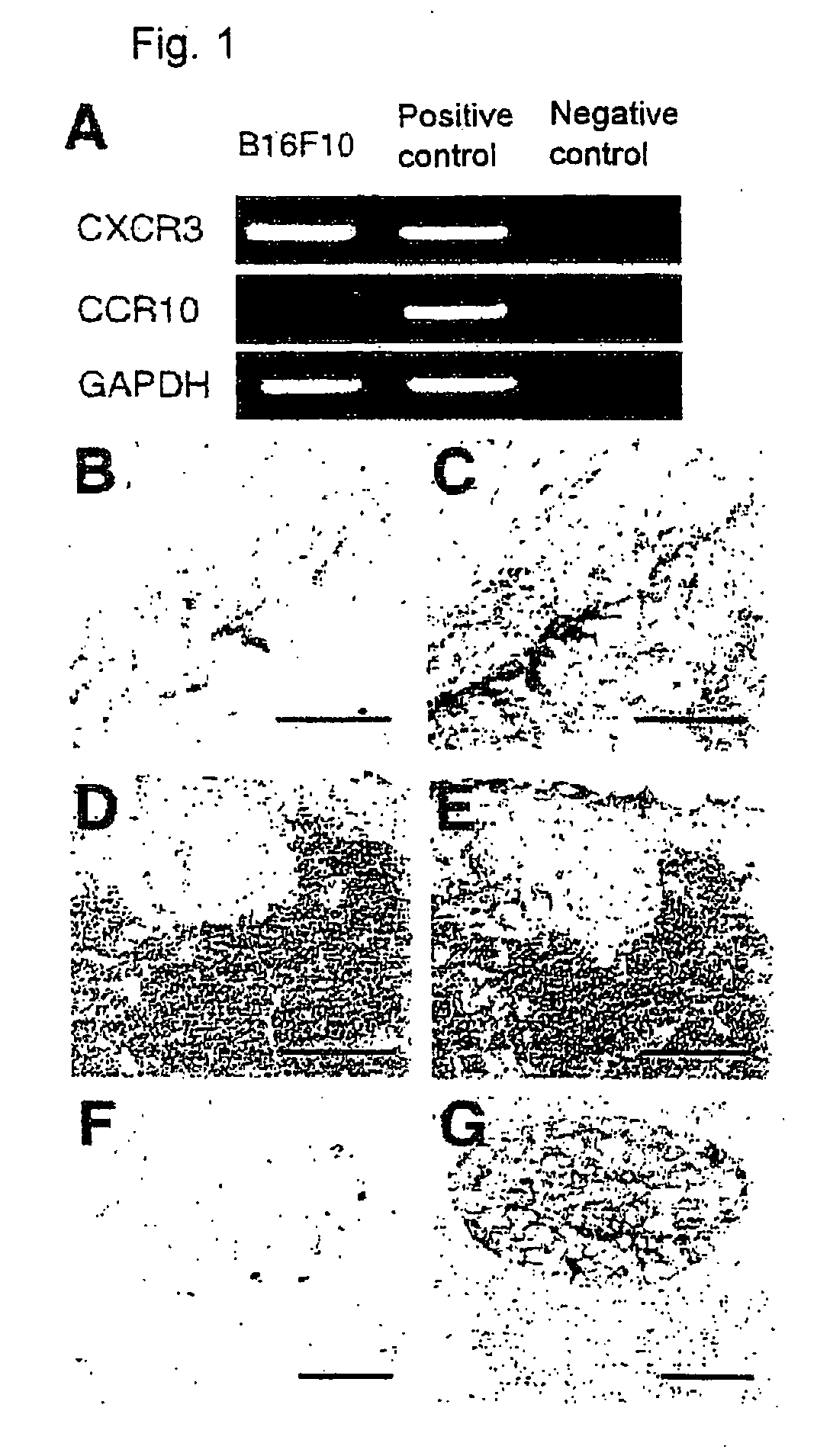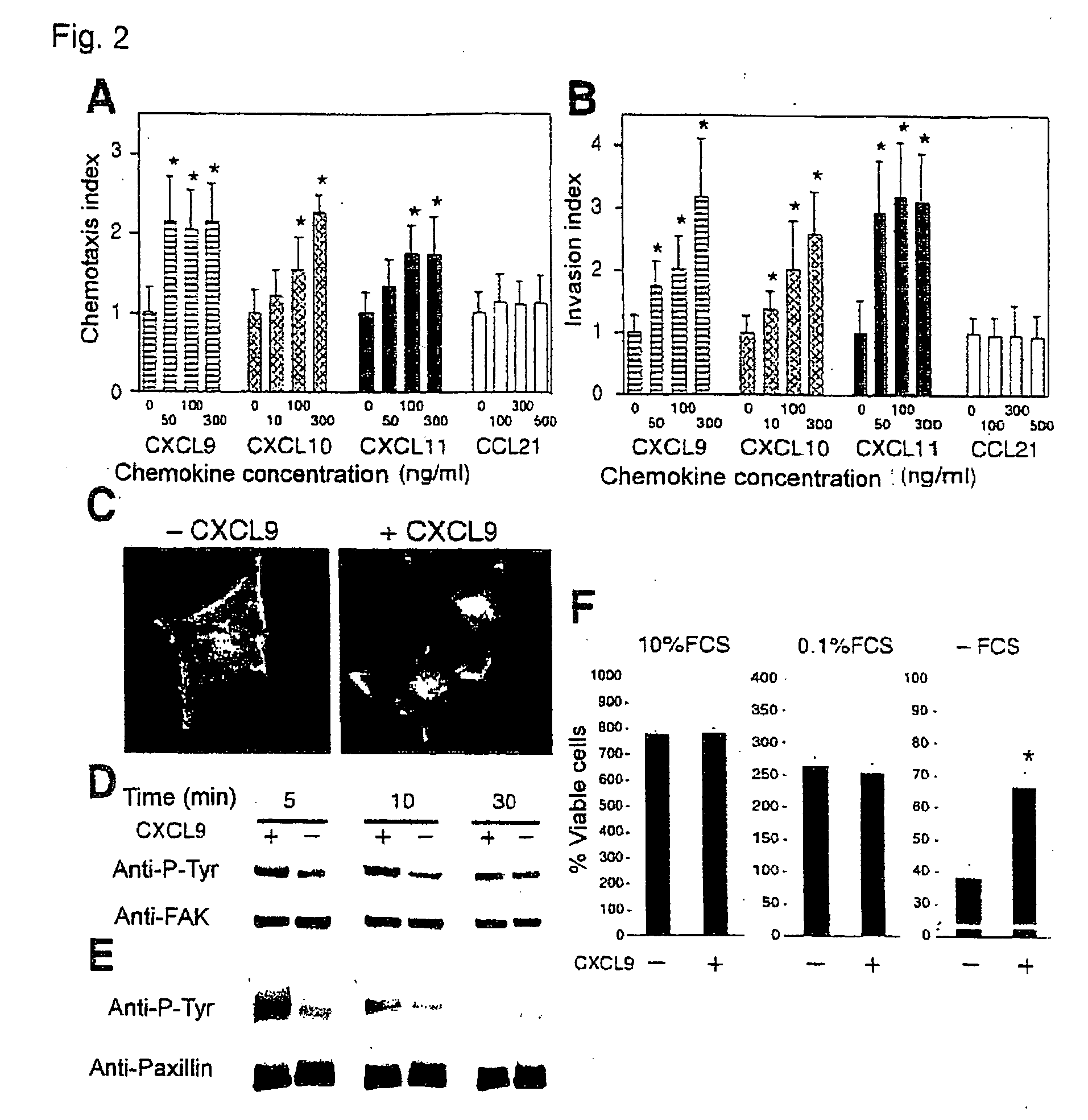Pharmaceutical composition comprising cxcr3 inhibitor
a technology of cxcr3 and inhibitor, which is applied in the direction of drug compositions, immunoglobulins against animals/humans, peptides, etc., can solve the problems of metastatic cancer that cannot be detected by certain methods, and the current surgical and medical therapy available for metastatic cancer is not effective enough, so as to prevent survival and metastasis of cancer, and achieve long-term effectiveness
- Summary
- Abstract
- Description
- Claims
- Application Information
AI Technical Summary
Problems solved by technology
Method used
Image
Examples
example 1
CXCR3 Expression in Mouse Melanoma
[0104]The melanoma cell used in the example below was mouse melanoma cell line B16F10. The cell provides a useful model that can cause metastasis to lymph nodes in the syngeneic mouse (C57BL / 6) (Whalen, G. F. et al., Ann. Surg., 215: 166-171, 1992). Unless otherwise noted, the said cell and mouse were used.
I. Expression of Chemokine Receptors in a Metastatic Mouse Melanoma Cell Line (B16F10)
[0105]Expression of chemokine receptors in B16F10 cells was screened by RT-PCR.
(1) Detection of Chemokine Receptors by Rt-PCR
[0106]Total RNA from cultured cells was extracted using ISOGEN (Nippon Gene Co., Ltd.) according to the manufacture's protocol. Two μg of each RNA sample was reverse-transcribed and subjected to PCR under the following conditions: denaturation at 94° C. for 30 s; annealing at 58° C. for 30 s and extension at 72° C. for 1 min for total 35 cycles.
[0107]The primers for CXCR3 were as follows:
5′-GCCGGAGCACCAGCCAAGCCAT-3′,(SEQ ID NO: 3)and5′-AGGT...
example 2
Lymph Node Metastasis of Human Colon Cancer Cell Lines with Forced Expression of Cxcr3
I. CXCR3 Expression on Human Colon Cancer Cell Lines
[0167]Further examination into CXCR3-positive cancers was conducted. Ten kinds of human colon cancer cell lines (Colo205, HCT116, HT29, RKO, WiDr, DLD-1, SW480, LS174T, caco2 and HCT15 cell lines) were analyzed for expression of CXCR3 with human CXCR3 antibody (R&D Systems) by Western blot analysis, and CXCR3 expression was confirmed in Colo205, HCT116, HT29, RKO and WiDr cell lines (data not shown). DLD-1, non-expressing cell line, was used in the experiments below.
II. Lymph Node Metastasis of Cells with Forced Expression of CXCR3
[0168]The relation between CXCR3 and cancer metastasis was examined using human colon cancer cell line DLD-1 not expressing CXCR3. Thus, DLD-1-CXCR3 with forced expression of mouse CXCR3 and DLD-1-EV containing an empty vector without CXCR3 were prepared using DLD-1 cells, and CXCR3 expression in respective cells was ana...
PUM
| Property | Measurement | Unit |
|---|---|---|
| concentrations | aaaaa | aaaaa |
| concentrations | aaaaa | aaaaa |
| weight | aaaaa | aaaaa |
Abstract
Description
Claims
Application Information
 Login to View More
Login to View More - R&D
- Intellectual Property
- Life Sciences
- Materials
- Tech Scout
- Unparalleled Data Quality
- Higher Quality Content
- 60% Fewer Hallucinations
Browse by: Latest US Patents, China's latest patents, Technical Efficacy Thesaurus, Application Domain, Technology Topic, Popular Technical Reports.
© 2025 PatSnap. All rights reserved.Legal|Privacy policy|Modern Slavery Act Transparency Statement|Sitemap|About US| Contact US: help@patsnap.com



